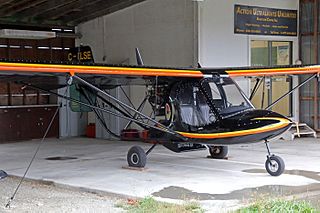The Advanced Aviation Explorer is a two-seat ultralight marketed in kit form, for amateur construction. It is a high-wing taildragger aircraft of pusher configuration with tandem seating.

The Weedhopper is an American high-wing, tractor configuration, tricycle gear, two-axis control ultralight aircraft originally developed by John Chotia during the height of the 1970s ultralight boom and introduced in 1977. When it was in production the aircraft was sold as a kit for amateur construction and could be assembled in 25-30 man-hours.
The Airdrome Dream Classic is a minimalist, high wing, single seat, single engine ultralight aircraft inspired by the 1908 Santos-Dumont Demoiselle and produced in kit form by Airdrome Aeroplanes of Holden, Missouri.
The Freebird II is a family of American side-by-side two-seat, high wing, tricycle gear, pusher configuration single engined kit aircraft originally designed for construction by amateur builders by the Freebird Airplane Company of Marshville, North Carolina and later Pro Sport Aviation of Wingate, North Carolina.
The Excalibur is an American two seats-in-tandem, high wing, pusher configuration ultralight aircraft that is manufactured in kit form for amateur construction, by Excalibur Aircraft of Sebring, Florida. It was introduced in 1993.

The Sorrell Hiperlight is a family of single and two seat, negative stagger biplanes, designed for amateur construction.
The Kolb Kolbra and King Kolbra are a family of American tandem two seater, high wing, strut-braced, pusher configuration, conventional landing gear-equipped ultralight aircraft that are produced in kit form by New Kolb Aircraft of London, Kentucky and intended for amateur construction.
The Loehle Sport Parasol is an American single-seat, parasol winged, single engine, ultralight aircraft produced in kit form by Loehle Aircraft for amateur construction. The aircraft meets the requirements of the US FAR 103 Ultralight Vehicles regulations.
The Rocky Mountain Wings Ridge Runner is a family of American high wing, strut-braced, single engine, conventional landing gear aircraft that were designed by Stace Schrader and were produced by Rocky Mountain Wings of Nampa, Idaho for amateur construction from 2000 to 2018.
The Flying K Sky Raider is a family of American, high wing, strut-braced, single engine, conventional landing gear ultralight aircraft that was designed by Ken Schrader and produced by Flying K Enterprises and later Sky Raider LLC of Caldwell, Idaho for amateur construction.
The Loehle SPAD XIII is an American single-seat ultralight aircraft scale replica of the First World War SPAD XIII fighter produced in kit form by Loehle Aircraft for amateur construction.

The Carlson Sparrow is a family of American, high wing, strut-braced, single engine, ultralight aircraft that was designed by Ernst W. Carlson and produced by Carlson Aircraft of East Palestine, Ohio and later Skyline Technologies of Salem, Ohio for amateur construction.

The Golden Circle Air T-Bird is a family of high-wing, strut-braced, pusher configuration ultralight aircraft that was produced by Teratorn Aircraft of Clear Lake, Iowa from 1983 to 1989 and then Golden Circle Air of De Soto, Iowa from 1989 until the mid-2000s. In 2011 the aircraft were back in production by Indy Aircraft. The aircraft is produced as a kit for amateur construction.

The Titan Tornado is large family of cantilever high-wing, pusher configuration, tricycle gear-equipped kit aircraft manufactured by Titan Aircraft of Austinburg, Ohio for amateur construction.
The Precision Tech Fergy F-II B is a two-seat side-by-side, conventional landing gear, strut-braced, high-wing, pusher configuration ultralight aircraft that was manufactured by Ferguson Aircraft and later Precision Tech Aircraft in kit form for amateur construction. The aircraft is out of production and no longer available.

The SlipStream Genesis is a family of American, strut-braced, high wing, pusher configuration, tricycle gear aircraft, produced in kit form, for amateur construction. Designed by Chuck Hamilton, the series were originally produced by Innovation Engineering of Davenport, Iowa and more recently by SlipStream International of Wautoma, Wisconsin.
The Arnet Pereyra Sabre II is an American, two-seats in side-by-side configuration, conventional landing gear-equipped, strut-braced, high-wing ultralight trainer that was produced by Arnet Pereyra Inc of Rockledge, Florida in kit form for amateur construction.

The Raj Hamsa X-Air is an Indian, two-seat, high-wing, tricycle gear, tractor configuration, ultralight aircraft produced by Raj Hamsa Ultralights of Bangalore, Karnataka in kit form, for amateur construction.
The Howland H-3 Pegasus is an American ultralight aircraft that was designed by Bert Howland and made available by Howland Aero Design in the form of plans for amateur construction, with kits provided by Aircraft Spruce & Specialty Co. The H-3 first flew in 1988.
The Apex Eco 6 is the first of a family of Czech single and two seat flying wing ultralight trikes that were designed and produced by To-Mi Aviation and later by Apex Aviation. The aircraft were supplied as kits for amateur construction.












